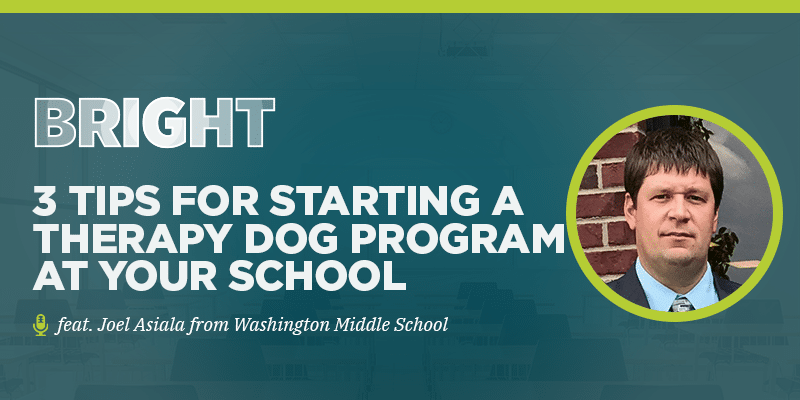Or listen on Apple, Spotify, Google, or another platform. Alternatively, you can read along with the transcript.
Joel Asiala started as the principal of Horizons Alternative High School right after the passing of Sweet Pea, a trained therapy dog belonging to one of the school’s teachers.
Staff and students alike missed their furry friend, who often came to visit them, so they asked Joel to bring in his family dog, Tucker, who happened to look an awful lot like their beloved Sweet Pea.
Joel’s initial reaction was, “I’m not bringing a dog to school. That’s crazy.” But members of his staff continued to encourage him, and finally, he agreed… and was astonished by the results.
One day while visiting the school, the friendly Labradoodle immediately made his way to the back of the classroom, where a student appeared angry and disengaged. Tucker laid his head on the student’s lap, and the adults watched on as the student began to pet him.
The school social worker asked, “What is your dog doing?”
To this, Joel replied, “Just sit back and watch.”
It wasn’t long — maybe eight or ten minutes — before the student was smiling and talking. When Joel called Tucker back up to the front of the classroom, the student followed him.
“This is absolutely amazing,” the social worker declared after watching this small miracle play out before him. “We need to get this in all of our schools.”
Today, Joel is the principal of Washington Middle School in Michigan’s northernmost school district, the Public Schools of Calumet, Laurium, and Keweenaw (CLK).
Our research team took a trip to visit CLK in early 2022 and wrote an in-depth report on their many student-centered learning initiatives. It’s worth a read to see how the therapy dog program complements a variety of other innovative programs designed to capture kids’ hearts and engage their passions.
In this episode of the BRIGHT podcast, I chat with Joel, and together we dig into:
- His district’s “student-first” approach and various programs their piloting to capture kids’ hearts
- Why he got his family pet, Tucker, trained as a professional therapy dog
- His top three tips for starting a therapy dog program at your school
You can listen to my conversation with Joel using the audio player above or by subscribing to the BRIGHT podcast in your app-of-choice (find us on Apple, Spotify, Google, and more) or by reading along with the transcript.
Of course, we understand that educators are busier than ever. If you don’t have time to listen to Joel’s full episode (which offers the fuller effect of his wisdom, energy, and examples), you can still benefit from a glimpse at his top three tips for starting a therapy dog program at your school below!
3 tips for starting a therapy dog program at your school
#1. Consider starting with a (hypoallergenic) adult dog with the right demeanor
Everyone loves puppies, so it’s tempting to begin there when you’re looking to start a therapy dog program.
But Joel says it can be better to start with a mature dog, either a current staff member’s family pet or an adoptable adult dog that has the right demeanor.
Why? It takes at least a year and a half to train a puppy to become a therapy dog, and there’s always a chance that the dog still may not have the appropriate demeanor to be surrounded by kids all the time.
It can be tough to make these decisions as a school leader, he admits, because many dog owners consider their pets to be family. But you have to be objective enough to determine which dog has the right personality to be around children in your school.
What are you looking for in terms of a dog’s demeanor? “You need to find a dog that is highly motivated by being pet and loved,” Joel clarifies. “One that is really laid back, doesn’t jump or bark, and isn’t aggressive.”
You’ll also want to find a hypoallergenic dog that can be bathed regularly to avoid allergy issues.
Another consideration: Therapy dogs should only be expected to work for a couple of hours per day to avoid overtaxing the dog. It’s often best to start with a dog who can be a “school pet” for most of the day when not officially “on the job.”
“It’s got to be natural,” he says. “The easiest thing to do would be to find a dog with the right temperament and slowly introduce them. If you have even 60 or 70 kids running around, that dog will become overwhelmed very quickly.”
#2. Take equal care in selecting the right handler for your therapy dog
“Finding the right dog is important,” Joel told me, “but finding the right person is almost as important or if not more important.”
Consider choosing someone who is going to be around the school a lot. As principal, Joel often walks around the school and visits classrooms, so it was a natural fit to get his family dog, Tucker, trained through a therapy program.
When they wanted to expand the program, the school’s trauma team asked staff to submit applications for serving as the handler and caretaker of their next therapy dog.
They chose Washington Middle School’s secretary, Nora Dee, to serve as the handler for Bleau, the next furry addition to their school staff.
Caption: Meet Bleau, one of Washington Middle School’s three therapy dogs.
“You want someone willing to walk the dog around a lot,” explains Joel. “Maybe you have a teacher with two prep hours, and they’re willing to do that. It takes a lot of time. It takes someone who is committed, who really wants to be with the dog, and believes in what it can do for the school.”
#3. Remember: Patience is key when it comes to animal behavior
This last part may seem obvious, but you must have patience when bringing a therapy dog or school pet into your school.
“A dog is a dog,” Joel explains. “It will go to the bathroom on the floor sometimes. It’s not always going to do what you tell it to do. It’s an animal, so you do need to have patience.”
It’s important to acknowledge and build in time for someone to train the dog, clean up after them, make sure they have food and water, let them out to go to the bathroom, etc. All of these things take time and patience!
It’s also important to note that the dog may not be able to come to school every day, depending on what the handler is doing after work.
As principal of his middle school, Joel cannot always bring his family dog, Tucker, to work. For example, on the day of our interview, he had two back-to-back meetings after school and didn’t want to make Tucker wait around all night before going home.
Patience is a requirement, but ultimately, Joel reminds us, it’s well worth the effort to see students smiling after spending time with one of their furry friends.
My favorite quotes from this episode
“It’s amazing when you see a kid that’s having a bad day after a therapy dog comes up to them and sits down. Those frustrations melt away when they’re on the floor with a dog rolling around. And I’ll tell you: It’s not only the students but the staff, too… I don’t know all the research. I just know that it works.”
“What we learned in our alternative school is you can do your social studies, you can do your science, you do your math, but if a kid doesn’t have passion behind it, they’re not going to do their best. At Horizons, we allowed students to go to the makerspace or the gaming room once they were done with their work. We had eSports, and we had a lot of success with that… You find something they’re passionate about, hone into it, and it’s amazing stuff.”
“I truly believe that if you can figure out how to work in the alternative setting and see success and bring that into your mainstream schools, you will be extremely successful. These are some of the students that struggle the most in your [traditional] classes. But they’re just classes. They’re just kids. No matter where you’re at, kids are kids. If you can figure out how to reach a population that struggles the most, that will only enhance your ability to reach the kids at the top, middle, and the bottom.”
“If you look at any philosopher, Maslow or Piaget or anybody that you learn about education, you’ll see that it’s about making sure students are fed, making sure that they feel safe, making sure they feel understood, and maybe even going so far as to make sure they feel loved or accepted. If you can get these things down, teaching is the easiest part. Getting the information is the easiest part if you have those other things in place.”
Related resources
- Read the full research report: Empowering teachers and Capturing Kids’ Hearts®: The Public Schools of Calumet, Laurium, and Keweenaw’s journey toward student-centered learning
- Learn more: Pet Partners – Therapy dogs and other therapy animals
- Learn more: Capturing Kids’ Hearts program

